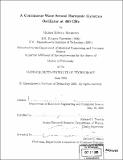A continuous-wave second harmonic gyrotron oscillator at 460 GHz
Author(s)
Hornstein, Melissa K. (Melissa Kristen), 1977-
DownloadFull printable version (22.73Mb)
Other Contributors
Massachusetts Institute of Technology. Dept. of Electrical Engineering and Computer Science.
Advisor
Richard J. Temkin.
Terms of use
Metadata
Show full item recordAbstract
We report the short pulse and CW operation of a 460 GHz gyrotron oscillator both at the fundamental (near 230 GHz) and second harmonic (near 460 GHz) of electron cyclotron resonance. During operation in a complete CW regime with 12.4 kV beam voltage and 135 mA beam current, the gyrotron generates a record 8 W of power in the second harmonic TE0,6,1 mode at 458.6 GHz. Design at high frequency, second harmonic, and low beam power is challenging because the latter two involve lower gain than at fundamental modes and all three necessitate higher Q cavities. Under complete computer control, the gyrotron has stably operated continuously for over an hour near 460 GHz. Diagnostic radiation pattern measurements of the beam using an array of pyroelectric sensors show a bi-Gaussian beam with 4% ellipticity. Operation in the fundamental modes, including the TE₀ ₃ ₁ mode at 237.91 GHz and the TE₂ ₃ ₁ at 233.15 GHz, is observed at peak output powers up to 70 W. CW studies of the fundamental TE₂ ₃ mode at low voltage reveal that the mode can be excited with less than 7 W of beam power at less than 3.5 kV. Further, we demonstrate broadband continuous frequency tuning of the fundamental modes of the oscillator over a range of more than 2 GHz through variation of the magnetic field alone. (cont.) We interpret these results in terms of smooth transitions between higher order axial modes of the resonator. In a related experiment, second harmonic (in addition to fundamental) operation of a nominally 250 GHz gyrotron oscillator was characterized to verify the possibility of second harmonic excitation at 460 GHz. The characterization experiments yielded results of extremely low second harmonic start oscillation currents, as low as 12 mA, and have been interpreted as an unintentionally high Q cavity. A computer-controlled stable CW source, the 250 GHz gyrotron was the first gyro-device specifically designed with the purpose of seamless integration into an NMR spectrometer. Under complete computer control, the gyrotron's operation for over 10 days has been observed, yielding a power stability of better than 1% and frequency stability of better than 400 Hz. Overmoded corrugated waveguide was designed and implemented to enable low loss quasi-Gaussian transmission. In conjunction with the corrugated waveguide, a quasi-optical directional coupler was designed and implemented to enable feedback on the forward (and reflected) power to further stabilize the signal. Radiation intensity patterns were compared using four techniques: thermal paper, liquid crystal paper, an array of pyroelectric sensors, and a mechanized scanner. (cont.) The liquid crystalline technique was adapted from a technique employed in temperature measurements in electronic devices. Originally employed for use in diagnosing laser beams, we demonstrate the first use of a pyroelectric camera at millimeter frequencies. A study of the overmoded microwave transmission and mode conversion system of a 140 GHz gyrotron oscillator, the first in a series of DNP gyrotrons, is also presented. The losses were characterized under a succession of iterative configurations for optimization of power transmission, including the design and implementation of a new TE₀ ₁ to TE₁ ₁ waveguide mode converter. The result of this study was a reduction of the total loss of the transmission system from nearly 9 dB to 4.5 dB. In addition to becoming a milestone in high frequency second harmonic design, the successful completion of the 460 GHz gyrotron experiment will allow the highest field DNP experiments to date. The success of experiments on three gyrotron oscillators, at 460, 250, and 140 GHz makes an important contribution to the body of knowledge on the development of high frequency, CW, second harmonic, and low power gyrotrons.
Description
Thesis (Ph. D.)--Massachusetts Institute of Technology, Dept. of Electrical Engineering and Computer Science, 2005. Includes bibliographical references (p. 255-266).
Date issued
2005Department
Massachusetts Institute of Technology. Department of Electrical Engineering and Computer SciencePublisher
Massachusetts Institute of Technology
Keywords
Electrical Engineering and Computer Science.